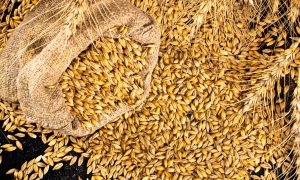Europe Wheat Starch Market Growth, Analysis, Share, Trends, Segmentation and Forecast to 2027

The Europe wheat starch market is projected to grow from US$ 274.37 million in 2019 to US$ 323.69 million by 2027, at a CAGR of 2.3%. This growth is driven by increasing demand in food and beverage applications, where wheat starch serves as a thickening and stabilizing agent. Additionally, the pharmaceutical sector utilizes wheat starch in tablet formulations. Germany, France, and the UK are key contributors to this market expansion. The rising preference for natural and gluten-free products further propels the demand for wheat starch in Europe.
Europe Wheat Starch Market Forecast to 2027 – Covid-19 Impact and Regional Analysis – By Type (Native Wheat Starch and Modified Wheat Starch); Grade (Food Grade and Industrial Grade); End Use Industry (Food and Beverages, Cosmetics and Others) and Country
The Europe Wheat Starch Market has been experiencing steady growth, driven by increasing demand for wheat starch in various industries such as food and beverages, pharmaceuticals, and industrial applications. As one of the largest starch markets globally, Europe plays a pivotal role in the production and consumption of wheat starch. Wheat starch, a key ingredient derived from wheat, is widely used in numerous food products, serving as a thickening, binding, and gelling agent Starch Market. The Europe Wheat Starch Market is highly influenced by several factors, including the rising consumer preference for natural and gluten-free products, the growth of the processed food industry, and the advancements in agricultural practices. Wheat starch, known for its versatility, has found applications in a wide range of food products such as sauces, soups, bakery items, and dairy products. Starch Market Additionally, it is used as a stabilizer in confectionery items and as a texturizing agent in plant-based foods, a trend gaining momentum in the European market.
The pharmaceutical sector also plays a significant role in the Europe Wheat Starch Market. Wheat starch is utilized in the production of tablets and capsules, where it serves as a filler, binder, and disintegrant. As the European healthcare industry continues to expand, the demand for wheat starch in pharmaceutical formulations is expected to rise steadily. Moreover, wheat starch is used in the manufacturing of adhesives, paper, and textiles, contributing to the market’s overall growth.
In recent years, the Europe Wheat Starch Market has seen increased demand for high-quality, non-GMO wheat starch due to the growing trend toward organic and sustainable food products. Consumers in Europe are becoming more conscious of the ingredients used in their food, driving food manufacturers to source high-quality wheat starch from trusted suppliers. The demand for wheat starch is further fueled by the expanding gluten-free product segment, as wheat starch is a suitable alternative for individuals with gluten sensitivities.
The market dynamics of the Europe Wheat Starch Market are also shaped by the regulatory environment in the region. The European Union has strict regulations in place regarding the production and labeling of food ingredients, including starch. These regulations ensure that wheat starch used in food products is of the highest quality and meets the safety standards set by regulatory authorities. This focus on quality and safety has enhanced consumer confidence in wheat starch-based products.
Germany, France, and the United Kingdom are some of the leading countries in the Europe Wheat Starch Market, with well-established production and consumption patterns. These countries are home to some of the largest wheat starch producers and suppliers in Europe, further driving the market’s growth. Additionally, the rising focus on sustainability and environmentally friendly agricultural practices in these regions is likely to boost the demand for wheat starch in the coming years.In conclusion, the Europe Wheat Starch Market is poised for continued growth, driven by increasing demand across various sectors such as food and beverages, pharmaceuticals, and industrial applications.
The List of Companies
Cargill Incorporated
Roquette Freres
The Archer-Daniels-Midland Company
Agrana Group
Tereos SA
Crespel and Deiters
New Zealand Starch Company
Sacchetto S.p.A.
With its versatility and wide range of uses, wheat starch is expected to remain a key ingredient in numerous European industries. The market will continue to be shaped by evolving consumer preferences, regulatory standards, and technological advancements in wheat starch production. As the demand for high-quality, sustainable wheat starch grows, the Europe Wheat Starch Marke will remain a significant player in the global starch industry.
Strategic Recommendations
For businesses looking to succeed in the European wheat starch market, here are some actionable recommendations:
Leverage Sustainability as a Differentiator
Sustainability is not just a trend; it’s becoming a core requirement in many European markets. Businesses that can position wheat starch as a sustainable and eco-friendly alternative will be better placed to attract environmentally-conscious consumers and comply with regulatory requirements. Marketing and product development strategies should emphasize the biodegradability and renewable nature of wheat starch.
Explore Niche Markets and Applications
While traditional applications of wheat starch in food and paper industries remain strong, there is growing interest in niche markets such as bioplastics, adhesives, and high-performance textiles. Companies should invest in R&D to develop wheat starch products that cater to these emerging applications, thus differentiating themselves from competitors.
Adapt to Regional Preferences
A one-size-fits-all strategy will not work in Europe. Businesses must tailor their approach to the specific needs of each region. For example, while Western Europe is focused on sustainability, Central and Eastern Europe may prioritize cost-efficiency. By understanding and adapting to regional nuances, businesses can better meet local demands and enhance their competitive positioning.
Focus on Gluten-Free and Health-Conscious Products
The rise of gluten-free and health-conscious consumer trends in Europe presents a significant opportunity for wheat starch in the food sector. Companies should explore opportunities to develop gluten-free food products or enhance their current product offerings with wheat starch to cater to this growing market segment.
Conclusion
The wheat starch market in Europe is dynamic and full of opportunities, driven by the increasing demand for sustainable, eco-friendly, and health-conscious products. To succeed, businesses must leverage current trends such as sustainability, technological innovation, and the rise of gluten-free foods. By understanding the unique characteristics of different European regions, companies can tailor their strategies, develop new value propositions, and gain a competitive edge in this rapidly evolving market. Strategic insights based on data-driven analysis will enable stakeholders to navigate the market effectively and make informed decisions that drive profitability and long-term success.
To read more about Wheat News continue reading Agriinsite.com
Source : Open PR
















